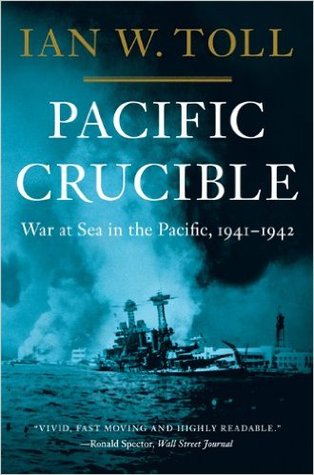More on this book
Community
Kindle Notes & Highlights
by
Ian W. Toll
Read between
September 20 - October 20, 2021
Later in the war, it would become a court-martial offense to refuse to act on good intelligence, but for now it was Fletcher’s privilege to ignore his intelligence officer if he so chose, and he did.
At 7:52 p.m., the Lexington went down in a cloud of hissing steam, taking the bodies of more than a hundred of her crew with her. About a minute later, a tremendous underwater explosion was felt and heard for miles around, even on the other ships of the American task force a full ten miles away. It was “Lady Lex’s” last defiant roar. She was on her way into the abyss.
Coral Sea, it is often said, was something new under the sun—the first naval battle in which the opposing ships never came into direct sight of one another. It was also one of the most confused and confusing battles in the history of war at sea, characterized on both sides by an almost incredible series of miscues, miscommunications, misidentifications, misinterpretations, and miscalculations.
As important as the Battle of the Coral Sea was to the United States, the battle was of supreme importance to Australia. Japanese possession of Moresby would have posed a serious threat to northern Australia’s cities and military bases. General MacArthur, who did not often praise the navy, said that the battle had been “the real safeguard of Australian independence.” It was, in a sense, Australia’s Trafalgar—a naval victory that shattered the hopes of a formidable would-be invader. For years after the war, the anniversary of the battle was celebrated by Australians as a quasi-national holiday.
The Midway operation was not a product of sound military planning. It was a farrago of compromises struck to quell internal dissent and to balance the demands of rivals in the Combined Fleet and the Naval General Staff. Not surprisingly, it was shot through with contradictions, flaws, and unnecessary risks. It exposed a fatal hubris and an unwarranted contempt for the enemy.
Underlying the planned Midway offensive was a casual and yet insidious assumption that Japan was fated to continue its run of victories, an affliction of mind that the Japanese later called, with the benefit of grim hindsight, shoribyo, or “victory disease.”
In the month between Coral Sea and Midway, Nimitz would be called upon to make the most high-stakes decisions of his forty-year naval career, and he was willing to risk everything, based on the best estimates of his intelligence advisers.
Midway attack force had required only fifteen minutes to rise en masse from the four flight decks of Kido Butai, and once aloft they had rendezvoused quickly and flown toward Midway in one huge, integrated formation. In June 1942, such a feat was simply beyond American capabilities. The Hornet and Enterprise had required a full hour to get their strikes in the air. Once aloft, they did not attempt to rendezvous; they did not even fly off in the same direction.
Now it was possible to see right through her to the other side.” Yamaguchi sent a profoundly unhelpful message: “Try to save your carrier!” (No reply was made, perhaps the most eloquent response possible under the circumstances.)
The entire ship twisted and whipped in a motion like a terrier shaking a rat.”
The pilots and plane crews had been driven too hard for too long, and were nearing the point of complete physical exhaustion. Yamaguchi ordered that the pilots be fed stimulants and given rice balls, which they devoured wolfishly.
One glance at the Hiryu was enough to know that her flight deck had been closed for good, and the Zero pilots who remained aloft now had to reckon with the knowledge that they were marooned in the air, with no friendly airfield within thousands of miles, and would have to fly around until their fuel tanks ran dry, and then execute that oxymoronic trick known as a “water landing.”
Nimitz had followed the course of the battle from the operation plot room in the CINCPAC headquarters. The room, as Layton described it, was “a rather primitive affair that consisted of a large chart of the Pacific laid over plywood across a pair of sawhorses.” Over that chart was placed a large sheet of tracing paper, and a staff officer continually drew, in blue crayon, the known position and tracks of American and Japanese fleet units.
That attitude was consistent with the teachings of Miyamoto Musashi, the renowned samurai swordsman of the sixteenth century. “As far as attacks made on you are concerned,” Musashi had advised, “let opponents go ahead and do anything useless, while stopping them from doing anything useful. This is essential to the art of war.”
Fired with overriding spirit, the Japanese at home and on the front lines would endure privations and hardships that the enemy could never withstand—they would work harder, eat less, and face death with samurai-like indifference. The new ethic was derived from traditional samurai and Zen ideas; at the same time it was a monstrous perversion of those ideas.
Between 1940 and 1943, Britain tripled its war production; Germany and Russia doubled theirs; and Japan increased its war production fourfold. In that three-year period, the United States multiplied its war production by twenty-five times.
Mahan to


